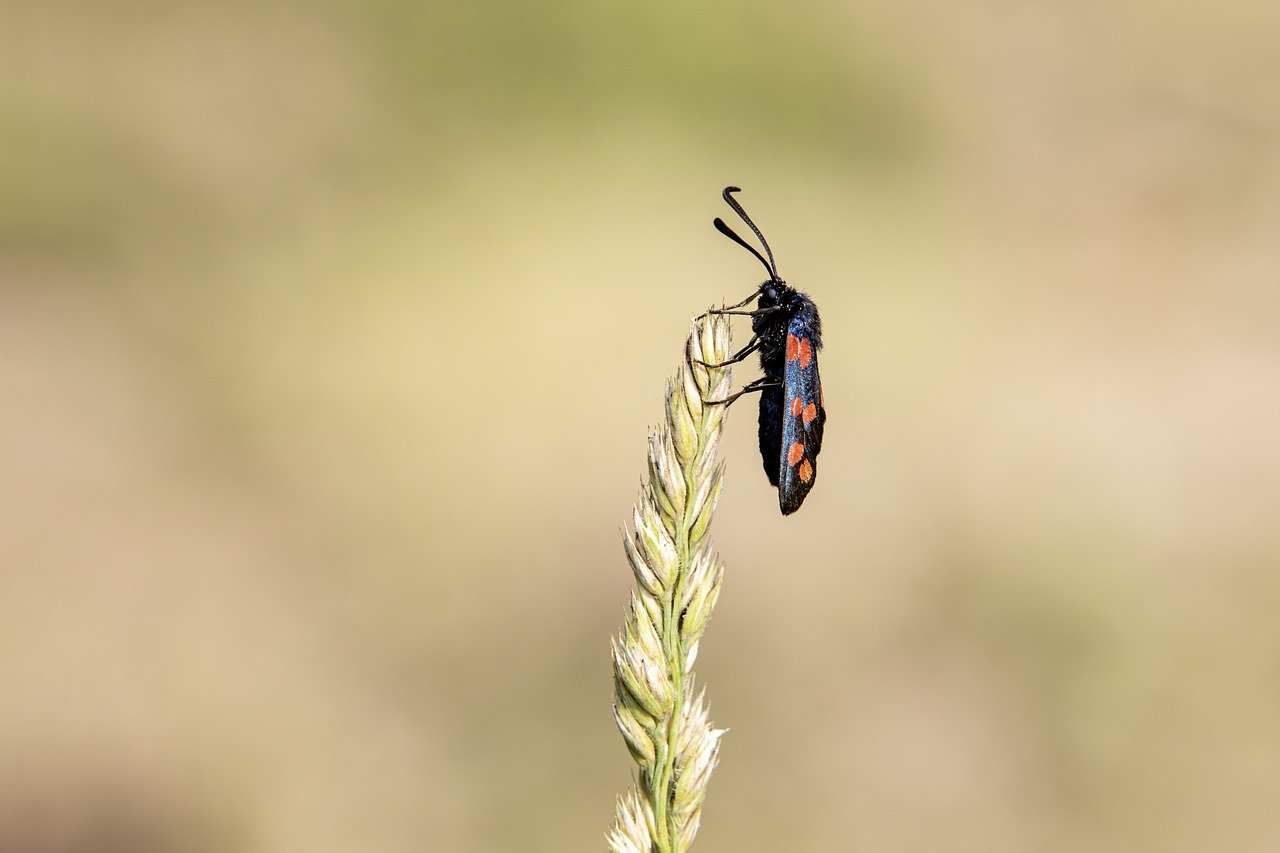The Narrow-bordered Five-Spot Burnet (Zygaena lonicerae) is a strikingly colored day-flying moth belonging to the family Zygaenidae. Known for its vivid red spots on a dark, metallic blue or black background, it is often mistaken for a butterfly due to its diurnal activity and vibrant appearance. This species is commonly found in Europe and parts of Asia, thriving in meadows and other open habitats.
Physical Description:
- Wingspan: Typically 30–38 mm.
- Forewings:
- Metallic blue-black with five red spots on each wing, often bordered by narrow bands of darker color, giving it its common name.
- The spots are oval or rounded and vary slightly in size.
- Hindwings: Bright red with a black border along the edges.
- Body:
- Cylindrical, with a metallic sheen similar to the forewings.
- Covered in fine, dark hairs.
- Antennae: Distinctly clubbed, a characteristic feature of burnet moths.
Behavior:
- Activity: Active during the day, especially in sunny weather. Often seen basking on flowers.
- Flight: Slow and fluttering, resembling that of a butterfly.
- Feeding: Adults feed on nectar, favoring plants like thistles, knapweed, and vetch.
Habitat:
The Narrow-bordered Five-Spot Burnet prefers open, sunny areas with abundant wildflowers. Common habitats include:
- Meadows and grasslands: Particularly those rich in wildflowers.
- Hillsides: Sunny slopes with flowering plants.
- Roadside verges: Where wildflowers grow undisturbed.
- Altitude: Found from sea level to mountainous regions, depending on the availability of host plants.
Distribution:
- Found across much of Europe and parts of Asia, especially in temperate climates.
- Absent from northernmost regions and very dry areas.
Life Cycle:
- Eggs:
- Laid in clusters on the underside of host plants, typically legumes like bird’s-foot trefoil (Lotus corniculatus) or clovers (Trifolium spp.).
- Eggs are pale yellow and hatch in about a week.
- Larvae:
- Caterpillars are pale green with black spots and yellow stripes, well-camouflaged among foliage.
- They feed on host plants and overwinter as larvae.
- Pupae:
- The caterpillars create a spindle-shaped, silken cocoon, often attached to grass stems or plant leaves.
- Pupation lasts 2–3 weeks in late spring or early summer.
- Adult:
- Emerges in early to mid-summer and lives for about 2–3 weeks.
- The primary goal is reproduction, as adults do not grow after emerging.
Defense Mechanisms:
- Aposematic Coloration: The bright red and black colors warn predators of toxicity. The moth contains cyanogenic compounds, making it distasteful or harmful to predators.
- Behavior: When threatened, the moth may exude a yellow liquid containing toxic chemicals from its body.
Conservation Status:
- Generally considered Least Concern, but populations can be affected by habitat loss due to agricultural intensification, mowing of meadows, and pesticide use.
- Conservation of wildflower-rich grasslands is essential for its survival.
Interesting Facts:
- Mimicry: Its bold coloration mimics other toxic species, enhancing its protection through predator avoidance.
- Slow Flight: Despite its toxicity, it relies on its warning colors rather than speed to deter predators.
- Pollination: By feeding on nectar, it contributes to the pollination of wildflowers.
Summary:
The Narrow-bordered Five-Spot Burnet (Zygaena lonicerae) is a beautiful and ecologically important species that graces wildflower meadows and grasslands. Its striking appearance and unique defense mechanisms make it a fascinating example of adaptation in nature. Conservation efforts to preserve its habitats ensure this vibrant moth continues to be a symbol of healthy, biodiverse ecosystems.
Views: 951
Subscribe to the newsletter:
